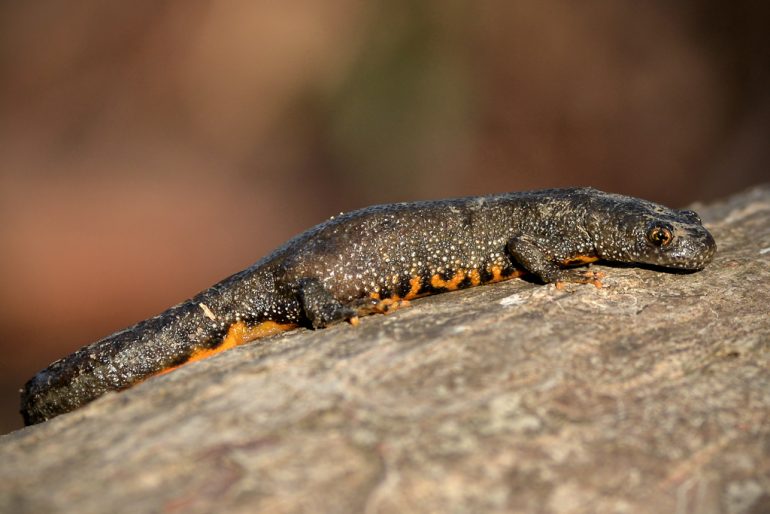In addition to being one of the most fascinating amphibians, the Great Crested Newt, also known as Triturus cristatus, plays an important role in the aquatic ecosystems’ biodiversity in Europe, thanks to its presence. Despite their importance, many people do not know much about them, and so the eDNA monitoring specialists at NatureMetrics have compiled ten fascinating facts about these mysterious newts, shedding light on their unique characteristics and the conservation efforts that are aimed at protecting them.
A Dazzling Transformation
During the breeding season, male Great Crested Newts go through a stunning makeover. They develop a beautiful, jagged crest that runs along their back and tail. This crest is what gives them their name, as well as their wonderfully attractive look. Nevertheless, this ostentatious characteristic has a purpose beyond mere showmanship, and is an essential component of their mating display, designed to attract females.
Walking With (Miniature) Dinosaurs
One of the characteristics that distinguishes these newts from others is their size. The Great Crested Newt is one of the largest newt species in Europe, with adults reaching a length of 18 centimetres, which is equivalent to about 7 inches.
Diverse Dwellings
During the mating season, these newts are most likely to be found in ponds and other bodies of water that move slowly and have a lot of vegetation in them. This is their preferred environment, but they are not only found in water; they are also adaptive animals that spend a significant amount of time in meadows, forests, and other places where the environment is damp and sheltered.
Food Addicts
Great Crested Newts aren’t particularly fussy eaters, and worms, insects and larvae are all examples of the types of invertebrates that are included on the menu for these creatures. The food they consume – which includes tadpoles and even the larvae of their own species – is a clear indication of their opportunistic eating habits.
The Kids Are Alright
In a meticulous plan to keep their young safe, female Great Crested Newts lay clutches of up to 250 eggs per clutch, meticulously encasing each egg in the leaves of aquatic plants. These larvae develop unique adaptations, such as external gills that allow them to breathe while underwater. The metamorphosis of these larvae into fully grown newts, prepared to begin their existence on land, takes place after three months of growth and change.
Extraordinary Lifespan
As evidence of their adaptability and the delicate ecology in which they thrive, Great Crested Newts can survive for up to fifteen years in the wild. The significance of their preservation is underscored by the fact that they live longer than any other amphibian.
Keeping them safe
The Bern Convention and the European Habitats Directive have acknowledged the Great Crested Newt as a protected species throughout Europe. To protect these animals from injury and the loss of their habitat, the UK passed the Wildlife and Countryside Act in 1981.
Even though they are protected, Great Crested Newts are still in danger from things like pollution, development, and the loss of their habitat. The decrease in their populations caused by these issues highlights the importance of ongoing conservation efforts, and the importance of looking after them when we come across them in the wild.
Great Crested newts have been subject to stringent protection measures in response to the dangers they face. Restoring their habitat, building additional ponds, and educating the public about their situation are all part of the solution.
What to do if you see a Great Crested Newt
Encountering a Great Crested Newt in the wild is a special and rare experience, given their protected status and declining populations. If you’re fortunate enough to spot one, it’s essential to handle the situation with care to ensure the newt’s safety and well-being.
Observe from a Distance
The best way to enjoy any wildlife encounter is to observe from a distance. This minimises stress for the animal and reduces the risk of unintentionally harming them. Great Crested Newts are particularly sensitive during their breeding season, so it’s crucial to avoid disturbing their natural behaviours.
Do Not Handle
As tempting as it may be to pick up and examine a Great Crested Newt, handling them can cause stress and potential harm. Their skin is permeable and sensitive to oils, salts, and chemicals on human skin. If there is an absolute need to move the newt (for example, if it’s in a dangerous location), use clean, wet hands or a wet cloth, and gently relocate it a short distance to a safe, moist habitat.
Protect Their Habitat
If you discover a Great Crested Newt or their habitat on your property, consider yourself a guardian of a valuable ecosystem. Avoid using pesticides or chemicals near ponds or water bodies and maintain natural vegetation around these areas to provide shelter and breeding grounds for the newts.
Report Your Sighting
Reporting your sighting can contribute valuable data to local wildlife organisations and conservationists working to protect and understand Great Crested Newts. In the UK, you can report sightings to Amphibian and Reptile Conservation (ARC) or your local wildlife trust. This information helps in monitoring their populations and the effectiveness of conservation efforts.
Follow Local Guidelines
In many places, Great Crested Newts are legally protected, and disturbing them or their habitat can be illegal. Familiarise yourself with local wildlife protection laws and guidelines to ensure you’re not inadvertently breaking any regulations. If you’re involved in land development or landscaping, seek advice from environmental consultants to navigate any necessary legal protections for the newts.
Encourage Conservation Efforts
Support local and national conservation efforts by participating in habitat restoration projects, volunteering for wildlife surveys, or donating to organisations dedicated to amphibian conservation. Raising awareness about the importance of protecting species like the Great Crested Newt can also inspire others to act.
Encountering a Great Crested Newt is a reminder of the fragile beauty of our natural world and the responsibility we have to protect it. By following these guidelines, you can ensure that your encounter leaves a positive impact on the future of this remarkable species.





